3.3 The Baroque: a Step Beyond
As Hellenism followed Classical Greek style, so the Baroque follows the Renaissance. The word baroque can designate “art of any time or place that shows the qualities of vigorous movement and emotional intensity.” In terms of Western art history, it specifies 17th Century art especially in Italy, which displays “overt rhetoric and dynamic movement” (Baroque). Baroque painters followed the lead of Renaissance masters but exchanged Realism for Idealism.
The Italian Baroque
Caravaggio, the Pope’s Bad Boy
Renaissance painters embedded religious and mythic scenes in human figures, landscapes and architecture rendered with mimetic precision. Caravaggio developed these techniques but laid aside Renaissance masters’ idealized pursuit of beauty to achieve a gritty realism.
 |
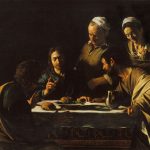 |
| The Calling of Saint Matthew. (1600). Oil on canvas. | Supper at Emmaus. (c 1606). Oil on canvas. |
Caravaggio’s biblical scenes are vividly set in the mean streets of Rome. In Calling of St. Matthew, the tax collector disciple (Matthew 9.9) is called away from a gambling table in a Roman tavern. In Supper at Emmaus, the resurrected Christ converses and breaks bread with people whose weathered faces testify to years of laborious life (Luke 24.13-49).
Caravaggio enhances the dramatic force of his paintings’ narratives with intense contrasts between light and shadow. He would lay in a dark background on the canvas, then build up figures and light to spotlight characters as if on a stage. Notice above how light follows the line of Jesus’ pointing arm and figure to call Matthew. His Beheading of John the Baptist locates the action in a back alley, witnessed by prisoners behind bars and lit with the skill of a stage designer.
 |
Beheading of John the Baptist. (1608). Oil on canvas. |
Intense contrast of light and shadow came to be called Chiaroscuro, Italian for light-dark (Chiaroscuro). It can be seen in Leonardo (e.g. Virgin of the Rocks) and in Rembrandt (see below). Chiaroscuro played a powerful role in black and white cinematography: German Expressionism in the silent era and what French critics termed Film Noir, i.e. dark cinema, marked by dark themes and dramatically lit visuals.
Intense spotlighting led Caravaggio to develop depths of narrative insight seldom found in paintings. He probes the inward turmoil of characters in crisis and, perhaps because of his own struggles with wickedness and redemption, fearlessly explored the flashpoint of sin and grace. We see this in his profoundly humanized Incredulity of Saint Thomas. Thomas, the disciple who doubted Jesus’ resurrection (John 20.24–29) is too often dismissed as a faithless failure. Yet Jesus meets his disciple’s spiritual struggle with grace and generosity:
A week later his disciples were in the house again, and Thomas was with them. … Jesus came and stood among them and … said to Thomas, “Put your finger here; see my hands. Reach out your hand and put it into my side. Stop doubting and believe.” Thomas said to him, “My Lord and my God!”
Caravaggio’s Thomas is all too human, probing Christ’s living tissues beneath a furrowed brow that intensely seeks truth. Doubt, faith’s other side, engenders an intimate encounter with the incarnate Lord.
 |
 |
| The Incredulity of Saint Thomas. (ca. 1601-1602). Oil on Canvas. | David & Head of Goliath. (1610). Oil on Canvas. |
Caravaggio’s life was steeped in humanity fallibility. After killing a man in a street brawl, Caravaggio was banished from Rome. For years he beseeched the Pope for pardon. As an act of penance, he painted his own face on the head of Goliath held aloft by David. Caravaggio knew how to invest himself in his work!
Artemisia’s Heroic Women
Artemisia Gentileschi learned two lessons from her painter father’s mentor, Caravaggio:
- Chiaroscuro: focusing a painting’s narrative impact by building up dramatic light over a dark background
- Realism: non-idealized, gritty stagings of biblical and mythic scenes
Caravaggio’s Judith, a Jewish princess who saved her people by beheading the Babylonian general Holofernes in his drunken slumber, (The Book of Judith[1]) bravely completes her task despite her evident, arms-length revulsion.
 |
Caravaggio. (1598). Judith Beheading Holofernes. Oil on Canvas. |
In a series of quite different paintings, Artemesia’s Judith is a woman of power untroubled by such doubts. She wields her sword with a warrior’s focus and then cooly navigates the threats of the enemy, sword resting nonchalantly over a potent shoulder. Gentileschi ‘s Judith is a powerful woman, not a vulnerable girl displayed for the male gaze.
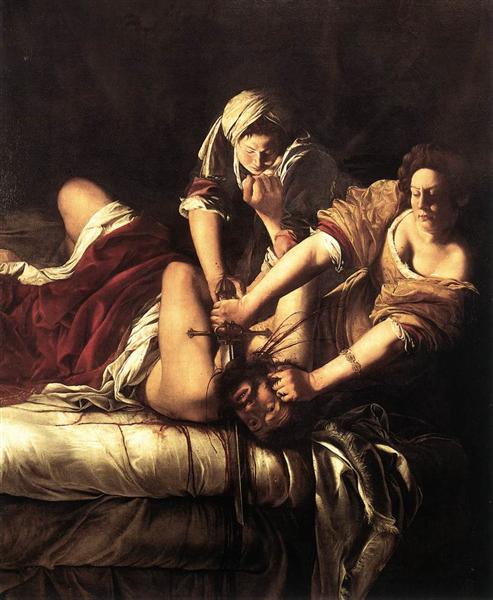 |
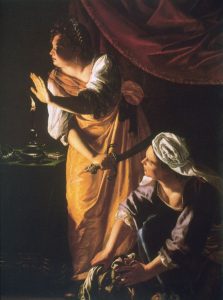 |
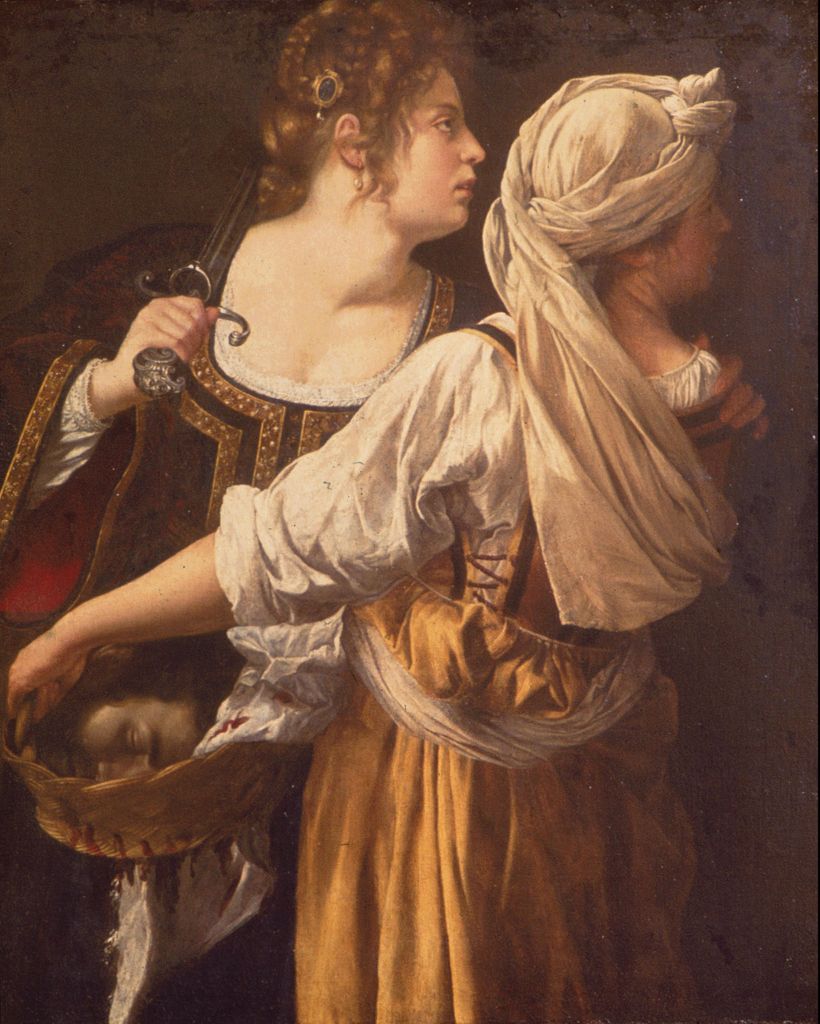 |
| Judith Slaying Holofernes. (1625). Oil on canvas. | Judith and her Maidservant (1614). Oil on canvas. | Judith and her Maidservant with the Head of Holofernes (1625). Oil on canvas. |
Artemesia throve within a tradition of feminism emerging among humanist scholars and female counter-Reformation leaders (Garrard, 1989, 143ff). She boldly inhabited roles monopolized by men: painter, entrepreneur, head of family. In letters to a patron, Don Antonio Ruffo, Artemisia confronts the challenges she faced with male patrons (Trans. Garrard, 1989, Appendix A):
- “You think me pitiful, because a woman’s name raises doubts until her work is seen” (Letter 16).
- “You will find the spirit of Caesar in this soul of a woman” (Letter 24).
- “If I were a man, I can’t imagine it would have turned out this way”[2] (Letter 25).
Determined “to compete with topflight male artists” (Garrad, 1989, 6), Artemisia incorporated avant garde styles and in turn influenced traditional art communities: she is widely recognized for having brought Caravaggio’s techniques to Florence. She mastered prestigious religious and mythic genres while reconfiguring them to reflect a woman’s point of view, what Garrad describes as an “inspired transformation of formal prototypes,” “a special mixture of masculine and feminine elements” (7). In contrast to male painters’ often erotic portrayals of the feminine ideal, her images embraced “ average, imperfect women” with realistic depictions of what are harshly thought of as physical flaws (Barker, 2022, 93, 123).
 |
Artemisia Gentileschi. (1639). Self-Portrait as the Allegory of Painting.Oil on canvas. |
Figures of women were frequently painted to personify abstract qualities, virtues, vices, or professions. Artemisia’s allegory of Painting—in Italian, Pittura—portrays herself at work, brush hand reaching upward for inspiration, palette hand resting firmly on the horizontal stability of the world (Garrard, 1989, 367). Her gaze peers at and into her subject: her own mirrored image, portal to the inwardness from which her art flows. Perhaps most remarkably, the canvas on which Pittura paints is presented as a negative space rich with the textures of the actual painting’s canvas: a celebration of the medium prefiguring the Impressionist revolution two centuries later.
[1] The Book of Judith was included in the Vulgate, St. Jerome’s Latin translation of Hebrew scriptures and the basis for Roman Catholic scripture ever since. In the 17th Century, Protestant translations of the Bible excluded Judith and other so-called “apocryphal” books from the Protestant biblical canon.
[2] Turned out this way: the reference is to a bishop who commissioned a painting, asked for preliminary drawings, then hired someone cheaper to complete the work.
Dutch Masters
In the 17th Century, the Netherlands commanded the greatest trading fleet and wealthiest trading colonies on earth. Dutch and Flemish merchants patronized some of the most accomplished painters in Europe. While the Italian Baroque was “associated with the Catholic Counter-Reformation,” the Dutch Baroque reflected the Netherlands’ militantly Protestant perspective. Reformed churches repudiated the Catholic veneration of saints, so the Dutch masters focused on contemporary scenes and quiet, domestic scenes (Baroque).
Johannes Vermeer
Vermeer was fascinated by apparently insignificant moments of domestic life. Below, a housewife stands at a window, reading a letter. As is normative in Vermeer’s work, a window in the upper left lights the scene, which is framed by the wall and a curtain.
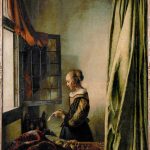 |
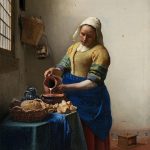 |
 |
| Woman reading a letter at window.(ca. 1659). Oil on canvas. | The Milkmaid. (1660).Oil, canvas | Girl with a Pearl Earring. (1665). Oil on canvas. |
Vermeer’s famous painting of The Milkmaid commemorates, not the wealthy homeowner, but a serving woman at her daily chores. The woman is lit from the upper left. Textures of dress, food, and pouring milk are exquisitely rendered and enriched by vibrant, ultramarine blues. In the famous Girl with a Pear Earring, however, the light source is not depicted, although the play of light is carefully delineated. The black background sets off subtle gradations of color and a face expressive of serene personality.
Rembrandt van Rijn
In Rembrandt, we see a powerful culmination of the developments emerging from the Renaissance. The brushwork. The Chiaroscuro. The Linear Perspective. The Foreshortening. And the dramatic intensity that emerged during the Baroque era. There is much to say, for example, about the Storm on the Sea of Galilee, and we will return to it. The scene dramatizes the incident remembered in Matthew 8, Mark 4, and Luke 8 in which Jesus calms a storm terrifying His disciples. Notice how Rembrandt uses zones of light to bring salvation to the men trapped in the darkness of the sea as a destructive element.
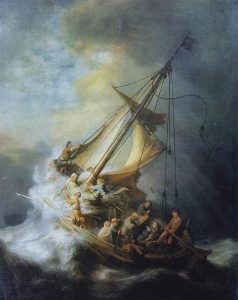 |
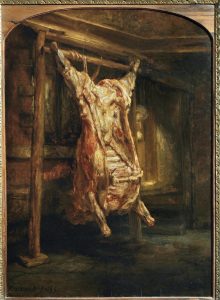 |
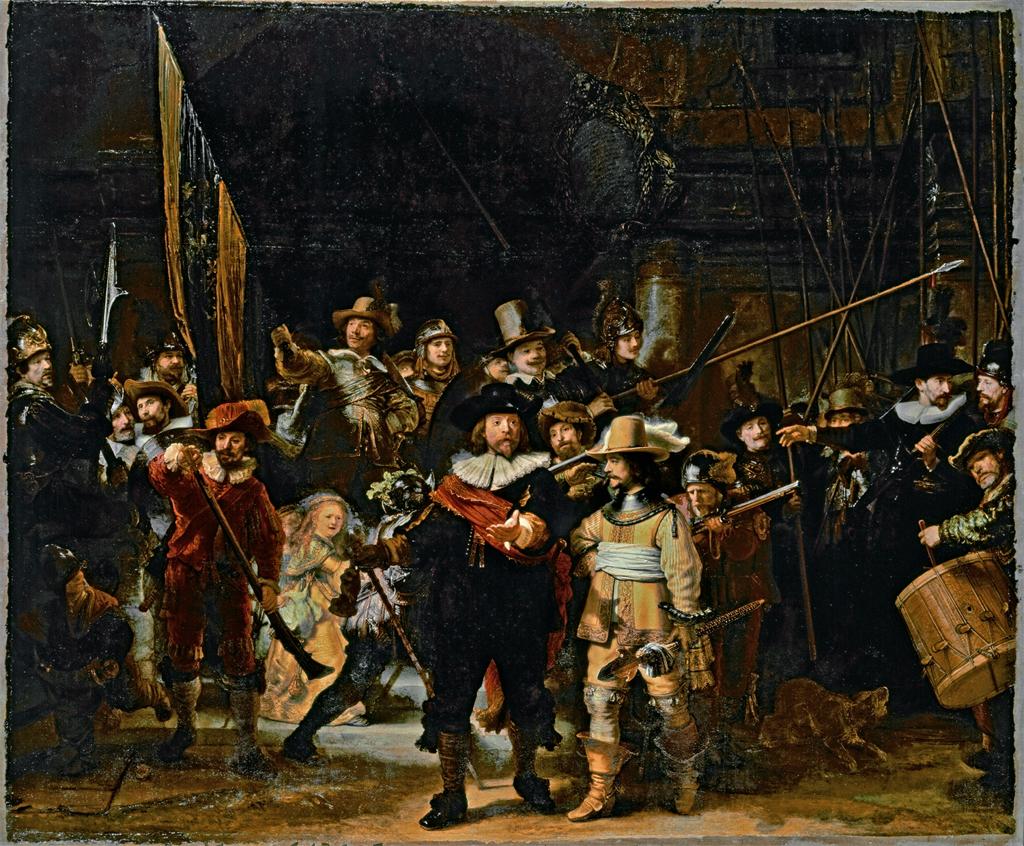 |
| Storm on Sea of Galilee. (1633). Oil on canvas | Slaughtered Ox. (1655). Oil on Panel. | The Company of Frans Banning Cocq and Willem van Ruytenburch, AKA The Night Watch. (1642). Oil on canvas. |
Fascinated as many painters have been with anatomy, Rembrandt transforms the genre of Still Life by picturing the carcass of a slaughtered ox. Rembrandt’s masterpiece, “so discolored with dirty varnish that it looked like a night scene,” was long mislabeled The Night Watch. The painting, over 12 by 14 feet, “showed remarkable originality in making a pictorial drama out of an insignificant event,” the mustering of a company of militia. The great canvas repays long study: “[subordinating] individual portraits to the demands of the composition,” Rembrandt injects an overflowing barrel of life into the scene, dozens of figures, prominent and obscure, caught in individual moments of drama.
References
Barker, S. (2022). Artemisia Gentileschi. Los Angeles: Getty Publications.
Baroque. (2004). [Article]. In I. Chilvers , (Ed.), The Oxford Dictionary of Art. Oxford University Press. http://www.oxfordreference.com.ezproxy.bethel.edu/view/10.1093/acref/9780198604761.001.0001/acref-9780198604761-e-269.
Caravaggio, M. (1608). Beheading of St. John the Baptist [Painting]. Valletta, Malta: St. John’s Co-Cathedral. ARTStor https://library-artstor-org.ezproxy.bethel.edu/#/asset/ARTSTOR_103_41822000467777
Caravaggio, M. (1599-1600). The Calling of Saint Matthew [Painting]. ARTstor https://library-artstor-org.ezproxy.bethel.edu/asset/SCALA_ARCHIVES_1039614343.
Caravaggio, M. (1609-1610). David with the Head of Goliath [Painting]. Rome: Galleria Borghese. ARTstor https://library-artstor-org.ezproxy.bethel.edu/asset/ARTSTOR_103_41822000467199.
Caravaggio, M. (ca. 1601-1602). The Incredulity of Saint Thomas [Painting]. Potsdam, Germany: The New Palace. ARTstor https://library-artstor-org.ezproxy.bethel.edu/asset/AIC_880031.
Caravaggio, M. (1598). Judith Beheading Holofernes [Painting]. Rome IT: Galleria nazionale d’arte antica (Italy) ARTStor https://library-artstor-org.ezproxy.bethel.edu/#/asset/SCALA_ARCHIVES_1031314640
Caravaggio, M. (1606). Supper at Emmaus [Painting]. Milan, IT: Pinacoteca di Brera, SSID 14502353. ARTStor https://library-artstor-org.ezproxy.bethel.edu/#/asset/SCALA_ARCHIVES_1039488838
Garrad, M. D. (1989). Artemisia Gentileschi: the Image of the Female Hero in Italian Baroque Art. Princeton, New Jersey: Princeton University Press.
Gentileschi, A. (1614). Judith and her Maidservant [Painting]. Florence, IT: Palazzo Pitti. ARTStor https://library-artstor-org.ezproxy.bethel.edu/#/asset/ARTSTOR_103_41822000567634
Gentileschi, A. (1625). Judith and her Maidservant with the Head of Holofernes [Painting]. Detroit, MI: Institute of Arts. ARTStor https://library-artstor-org.ezproxy.bethel.edu/#/asset/AIC_880037
Gentileschi, A. (1625). Judith Slaying Holofernes [Painting]. Florence, IT: Uffizi. ARTStor https://library-artstor-org.ezproxy.bethel.edu/#/asset/ARTSTOR_103_41822000589877
Gentileschi, A. (1639). Self-Portrait as the Allegory of Painting [Painting]. London, UK: Buckingham Palace Royal Collection. ARTStor https://library-artstor-org.ezproxy.bethel.edu/#/asset/AIC_880035
Langdon, A. (2001). Caravaggio. In Brigstocke, H (Ed.), The Oxford Companion to Western Art. Oxford University Press,. http://www.oxfordreference.com.ezproxy.bethel.edu/view/10.1093/acref/9780198662037.001.0001/acref-9780198662037-e-464.
Rembrandt. (1642). The Company of Frans Banning Cocq and Willem van Ruytenburch, known as The Night Watch. [Painting]. Amsterdam: Rijksmuseum. ARTstor https://library-artstor-org.ezproxy.bethel.edu/asset/ARIJKMUSEUMIG_10313629310.
Rembrandt. (1661). Self-portrait with palette and brushes. London, UK: Iveagh Bequest, Kenwood. ARTstor https://library-artstor-org.ezproxy.bethel.edu/asset/ARTSTOR_103_41822000702900.
Rembrandt. (1633). Storm on Sea of Galilee [Painting]. Boston, MA: Isabella Stewart Gardner Museum. Stolen—whereabouts unknown. ARTstor https://library-artstor-org.ezproxy.bethel.edu/asset/ARTSTOR_103_41822000427318.
Rembrandt. (1655). Slaughtered Ox [Painting]. Paris, France: Musée du Louvre. ARTstor https://library-artstor-org.ezproxy.bethel.edu/asset/LESSING_ART_10310119770.
Rembrandt. (2004). [Article]. In I. Chilvers (Ed.), The Oxford Dictionary of Art. Oxford University Press. http://www.oxfordreference.com.ezproxy.bethel.edu/view/10.1093/acref/9780198604761.001.0001/acref-9780198604761-e-2923.
Vermeer, J. (c.1665). Girl with a Pearl Earring [Painting]. The Hague: Mauritshuis. ID 670. ARTstor https://library-artstor-org.ezproxy.bethel.edu/asset/AWSS35953_35953_30941058.
Vermeer, J. (ca. 1660). The Milkmaid [Painting]. Amsterdam: Rijksmuseum. ARTstor https://library-artstor-org.ezproxy.bethel.edu/asset/ARIJKMUSEUMIG_10313628004.
Vermeer, J. (ca. 1659). Woman reading a letter at the open window [Painting]. Dresden, Germany: GemΣldegalerie. ARTstor https://library-artstor-org.ezproxy.bethel.edu/#/asset/LESSING_ART_10310752061.
Vermeer, Johannes [Article]. (2004). In I. Chilvers (Ed.), The Oxford Dictionary of Art. Oxford University Press. http://www.oxfordreference.com.ezproxy.bethel.edu/view/10.1093/acref/9780198604761.001.0001/acref-9780198604761-e-3632.
the 17th Century artistic tradition that followed the Renaissance, characterized by dramatic action, intense passions, chiaroscuro, and gritty social realism. More broadly, any art emulating the values of the Baroque
an era in 15th and 16th century Europe marked by a Renaissance—or rebirth—of interest in and knowledge of classical Greek learning through humanist scholarship that challenged medieval values. In painting and sculpture, the work of artists in Italy, Germany, and the Low Countries which broke with Byzantine conventions to explore the geometry of perception and locate images and actions in time and space
a focus in the arts on precise, detailed accuracy in representing subjects, including grittier darker aspects of human personality and experience. Often motivated by a skeptical reaction against the apparent illusion of idealized views of people, societies, or scenery.
a focus in the arts on beauty, inspiration, and visions of excellence that transcend the gritty realities of experience. Often satirized as illusory and misleading by reactionary movements focused on Realism.
a term used to describe the effects of light and dark in a work of art, particularly when they are strongly contrasting (Chiaroscuro). Associated with Baroque painting, but common in the art of the early 20th Century: e.g. German expressionism and film noir cinema.
French for dark cinema, a term coined by 1960s French film critics to describe films with dark themes and black and white film effects that strongly contrasted light and shadow. Characteristic of German Expressionism (1910s and 20s), Hollywood crime films (1930s and 1940s) and French post-war cinema (1940s and 50s).
a general term referring to innovative, experimental, potentially subversive artistic movements that challenge the conventions of the day.
particular types of composition marked by expected, conventional fea-tures: e.g. Japanese haiku, Chinese landscape painting, Renaissance son-net.
in the classical tradition of ancient Greece, a doctrine articulated by Plato in which flawed, observable objects suggest perfect exemplars in an inaccessible realm—the ideal horse, the ideal basket, etc. In classical Greek art, a precise (mimetic) imitation of, say, a human body adjusted to suggest the ideal through perfectly balanced order, proportion, and elegance
representation of an abstract concept as a symbol or person, often a personification of the idea
the methods and materials from which the work is forged, e.g. oil paint, mosaic, metric verse, prose narrative
the illusion of depth in a 2-dimensional image (e.g. a painting) in which lines angle toward a vanishing point
an illusion of depth created by contrasting the sizes of objects on the basis of how near or far they are from the eye of the viewer. E.g. a human figure in the foreground will be larger than a tall building in the distance.
a genre of painting, drawing, or photograph arranging inanimate objects such as fruit, flowers, pottery or furniture, usually in an interior scene.

